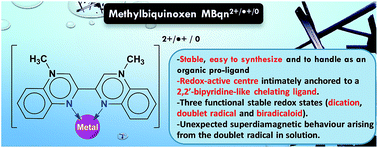A fascinating multifaceted redox-active chelating ligand: introducing the N,N′-dimethyl-3,3′-biquinoxalinium “methylbiquinoxen” platform†
Abstract
To intimately combine a chelating ligand function with the numerous properties of a viologen-like redox-active centre would offer a rare possibility to design controllable multi-redox states, whose properties arise from strongly correlated phenomena between the organic ligand as well as with any metalloid coordinated centres. Such a concept previously proved to be feasible, however is not widely applicable owing to challenges in terms of synthesis, isolation, and aerial sensitivity of both the ligand and its metal complexes. Here we report the first stable example of such a redox-active molecule, N,N′-dimethyl-3,3′-biquinoxalinium2+/˙+/0 “methylbiquinoxen, MBqn2+/˙+/0”, which shows a rich redox chemistry and chelates a metal ion in the case of the metal complex [CdCl2(MBqn0)]. This goes beyond what is possible to achieve using viologens, which are limited by not providing chelation as well as having no accessible biradicaloid state, corresponding to the neutral direduced MBqn0 open-shell behaviour we observe here.



 Please wait while we load your content...
Please wait while we load your content...